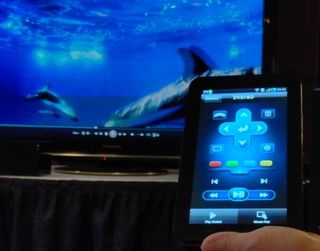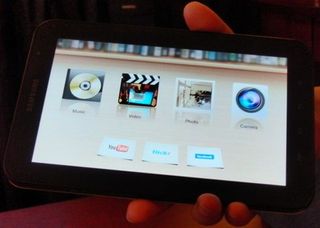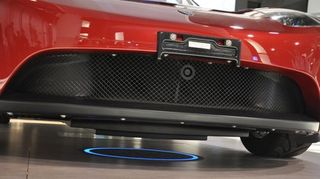Around the floor: the hidden gems of CES 2011
Next-gen touch, ubiquitous power and health helpers
SURC's $70 universal learning remote control fits onto an iPhone 4 like a case, weighs just 20 grams and uses an app to control just about any device; when it comes out this spring you can download control codes, learn them from any remote it doesn't know about and customise the interface to have just the buttons you want – plus you can use gestures like shaking the phone to turn the TV off.
The next version of PowerDVD will have an Android app that turns tablets into remote controls for controlling the DVD or Blu-ray player on your PC.
You can also use it to stream video and photos onto your PC and it uses PowerDVD's video tools to upscale it to HD, improve the lighting and colour and stabilise shaky video; Cyberlink is also working on a DLNA-connected Android media streaming app that will work even if you don't have PowerDVD.

CONTROL: Use Android as a remote control for PowerDVD

STREAM: Use a DLNA Android tablet to share pictures and video on a PC or DLNA TV
But the remote control we really want lets you wave your hand at a PC with a webcam and use that to bring up a gesture interface where you move your hand to trigger the forward, backward, mute and play button – that one is still a prototype.
More power more places
Get daily insight, inspiration and deals in your inbox
Get the hottest deals available in your inbox plus news, reviews, opinion, analysis and more from the TechRadar team.
There are plenty of modular universal chargers; the iDapt models work well and have tips that let you recharge AA and AAA batteries as well as most devices. On the way is a tip that will charge camera batteries, and an eco charger that has just one tip but comes apart to work in a car power socket as well as a standard power socket.
Powermat wireless charging is going to be in cars to charge your phone soon; eCoupled wireless power technology can charge the whole electric car – we saw it charging a Tesla from a power ring the size of a manhole cover.
That takes 1600W, 89 per cent efficiency and some fine control, but it's still safe to touch. At the other end of the scale, they can print a power receiver on a paper label in conductive ink that also transmits data; stick that onto a box of cereal and it can make an electroluminescent label light up to attract attention (handy to help you find what's on your shopping list or warn you which carton of milk is going to expire today).
A capacitive sensor printed on the side of a bottle can let you know when it's almost empty or whether you remembered to take your pill today.
A packet of soup could have a steel plate in the bottom; pop the safety tab to activate it, put it on top of a wireless power transmitter embedded in your kitchen worktop or your desk at work and it could heat itself up for the right amount of time – and when you take the soup off, you can pop something else on to charge.

FROM A PHONE: Qi wireless charging built into HTC smartphones…

TO A CAR: The same technology charging an electric car
HTC is the first manufacturer to offer a Qi wireless charging back as an option you can buy with a new phone, Dell uses eCoupled for its wireless power laptop, Duracell uses it for its cases and charging mats and more laptop and tablet makers are promising Qi wireless chargers.
Powermat and eCoupled use very different systems, but they're both signing up enough partners that we're close to having two wireless power standards that might (one day) interoperate.
------------------------------------------------------------------------------------------------------
- 1
- 2
Current page: Phone-based remotes and more power more places
Prev Page Health tech and improved touchMary (Twitter, Google+, website) started her career at Future Publishing, saw the AOL meltdown first hand the first time around when she ran the AOL UK computing channel, and she's been a freelance tech writer for over a decade. She's used every version of Windows and Office released, and every smartphone too, but she's still looking for the perfect tablet. Yes, she really does have USB earrings.
